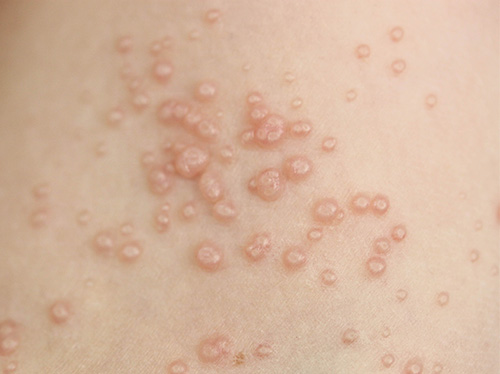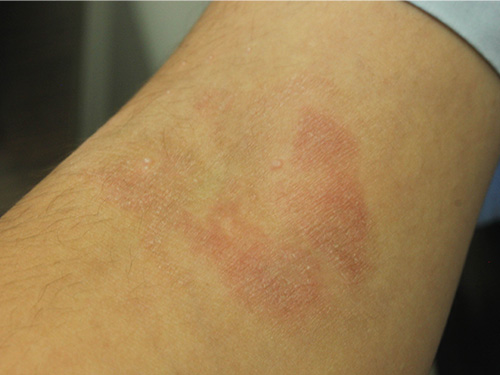Molluscum contagiosum
Molluscum contagiosum is a common contagious poxvirus infection that occurs mainly in children and young adults. It is characterised by small (usually up to 5 mm) discrete pearly papules with central umbilication—see here for a photo of molluscum contagiosum. Lesions are usually painless and not itchyThe Royal Children's Hospital (RCH), 2020. The virus is transmitted by direct skin contact, but fomites (eg bath sponges, bath toys, towelsThe Royal Children's Hospital (RCH), 2020, shared swimming equipment) and swimming pools (especially pools with untreated water [eg inflatable pools]) may also be a source of infection. Children with molluscum contagiosum should avoid sharing baths with siblings and other childrenThe Royal Children's Hospital (RCH), 2020. Sexual transmission of the virus occurs in adults and is often associated with genital molluscum lesions.


Molluscum contagiosum usually resolves spontaneously in immunocompetent patients; lesions can stay on the body for weeks, months, or sometimes more than a yearThe Royal Children's Hospital (RCH), 2020. The infection may be complicated by dermatitis, particularly in atopic patients (see here for a photo of molluscum with co-existing dermatitis). Large numbers of lesions and atypical lesions may occur in patients who are immunocompromised.
Discuss the natural course of molluscum contagiosum with the patient and their parents or carers. Although most cases of molluscum contagiosum resolve without treatment, lesions can be distressing (particularly if there is concurrent dermatitis), widespread or take more than a year to resolve. If lesions are on cosmetically sensitive areas, are widespread or persist longer than a year, consider referring the patient to a dermatologist or paediatrician.
Various treatments can be used for molluscum contagiosum, but most lack supporting evidencevan der Wouden, 2017. Topical imiquimod therapy is not recommended because it is tedious, expensive and not effectivevan der Wouden, 2017.
If the patient only has a few small lesions and prefers to remove them, treatment options include cryotherapy and curettage. Children may need a topical anaesthetic (eg topical lidocaine+prilocaine) before these procedures. Alternatively, apply adhesive tape on the lesions, leave on for 24 hours, then pull off rapidly. Rapid removal of tape produces an irritating effect desired for the treatment of molluscum contagiosum lesions. The more adhesive a tape is, the more irritating it is. Use adhesive tape with caution in patients with co-existing atopic dermatitis because this can irritate atopic dermatitis of the surrounding skin, which can cause more scratching and spread of molluscum contagiosum.
See the Royal Children’s Hospital (Melbourne) patient information sheet for more information on molluscum contagiosum (including more general measures to prevent spread of molluscum contagiosum).
